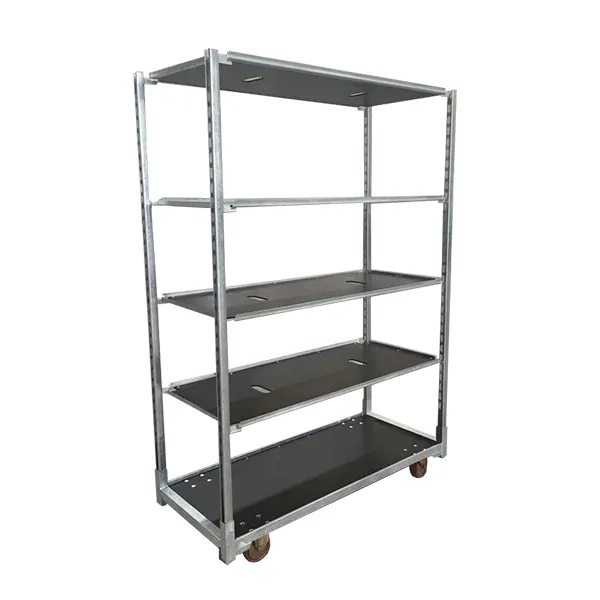Avoid your inquiry is delay response, please enter your WhatsApp/Skype along with the message, so we can contact you at the very first time.
We will reply you within 24 hours. If for urgent case, please add WhatsApp/WeChat: +8613791936882 ,. Or call +86-18678911083 directly.
When it comes to choosing the right trolley for your needs, weight and capacity are essential factors. Let’s take a closer look at how much a Danish trolley weighs and what that means for you.
A Danish trolley typically weighs between 25 to 40 kg, depending on the design and materials. It is designed to carry heavy loads efficiently, making it a popular choice in nurseries and warehouses.

Now that we know about the weight of a Danish trolley, it’s important to understand how weight capacities and loading techniques play a crucial role in making sure these trolleys are used efficiently.
Heavy-duty trolleys are built for strength and efficiency. If you need to transport heavy loads, understanding the capacity of these trolleys is crucial to avoid accidents or overloading.
Heavy-duty trolleys typically have a weight capacity ranging from 500 kg to 1,000 kg, depending on the model and design. These trolleys are designed for transporting bulky or heavy items.

Heavy-duty trolleys are essential in environments that require the transport of heavy goods, like warehouses or nurseries. The weight capacity depends largely on the materials used in the construction of the trolley. For instance, trolleys made with steel frames can handle much higher capacities compared to those with aluminum frames.
The strength of the wheels and axle design also play an important role. Larger, reinforced wheels with higher load-bearing capacity are commonly used in heavy-duty trolleys to ensure stability during transport.
In addition, the design of the trolley influences how evenly the weight is distributed, preventing tipping or damage. Some models even feature adjustable shelves or trays that help distribute the weight more evenly across the trolley.
| Material | Capacity | Common Usage |
|---|---|---|
| Steel Frame | 500–1000 kg | Warehouses, industrial sites |
| Aluminum Frame | 200–500 kg | Retail, light-duty transport |
| Plastic Frame | 100–300 kg | Nurseries, light gardening |
Hand trucks are essential for moving heavy items quickly. But how much can one person safely handle with this tool? Let’s explore the typical weight limits.
A standard hand truck can carry anywhere between 250 to 500 pounds (around 115 to 225 kg) per load, depending on the design and construction. However, it’s important to maintain balance and stability while moving heavy items.

Hand trucks, also known as dollies, are ideal for moving boxes, appliances, and other heavy items. The capacity of a hand truck varies based on its design. Heavy-duty hand trucks are built to carry more weight and are typically made with durable materials like steel or reinforced aluminum. These trucks are equipped with a two-wheel system that helps to distribute the weight effectively.
While the design of the truck is important, so is the technique used. It’s critical to maintain a balanced load, as improper loading can cause tipping, especially when the weight distribution is uneven. Hand trucks are also typically designed for flat surfaces. If you’re planning to move heavy loads up or down stairs, it’s best to use a stair-climbing dolly1 or use assistance.
The comfort of the handles and the ergonomic design of the truck also play an important role. A well-designed hand truck will reduce the strain on your body, especially for long-distance moves.
| Type | Capacity | Common Use |
|---|---|---|
| Standard Hand Truck | 250–500 lbs (115–225 kg) | Moving boxes, furniture |
| Stair-Climbing Hand Truck | 300–500 lbs (135–225 kg) | Moving items up/down stairs |
| Appliance Dolly | 500–800 lbs (225–360 kg) | Heavy appliances, large furniture |
Loading a trolley properly is just as important as knowing its capacity. Let’s take a look at the correct way to load a trolley to ensure safety and stability.
The proper loading of a trolley2 involves evenly distributing the weight, securing items to prevent shifting, and not exceeding the trolley’s weight capacity. A balanced load is essential for smooth transport.

Proper loading is crucial to the safety and efficiency of any trolley. First, always check the weight capacity of the trolley you’re using and ensure that the load doesn’t exceed it. This prevents overloading, which can damage the trolley or cause accidents during transport.
To load the trolley correctly, begin by placing heavier items at the bottom. This helps keep the center of gravity low, reducing the chance of the trolley tipping over. If you’re using a trolley with multiple shelves or levels, always place the heaviest items at the lowest level, ensuring a stable base.
Make sure that lighter items are placed on top or in areas where they won’t be at risk of shifting. Items should be arranged evenly across the trolley to prevent instability. If necessary, secure the load with straps or other restraints to keep the items from shifting during movement.
For narrow or small trolleys, it’s crucial to pay attention to weight distribution to prevent tilting.
| Loading Step | Key Consideration |
|---|---|
| Distribute Weight Evenly | Prevents tipping and ensures stability |
| Secure Items | Keeps the load in place during transport |
| Keep Heaviest Items Low | Low center of gravity for balance |
Flatbed trolleys are incredibly versatile, but what is the maximum weight they can carry? Let’s look at the weight limits and how to use these trolleys safely.
The maximum weight capacity for flatbed trolleys generally ranges from 500 kg to 1,000 kg, depending on the model. It’s important to check the specifications before loading to avoid overburdening the trolley.

Flatbed trolleys are ideal for carrying large or awkwardly shaped items. They have a larger surface area than traditional trolleys, allowing them to accommodate bulkier items. However, just like other trolleys, flatbeds also have weight limits. These limits vary depending on the design and material of the trolley. Some flatbed trolleys are made with reinforced steel or aluminum, allowing them to carry heavier loads.
To safely use a flatbed trolley, always ensure that the load is evenly distributed. Since flatbed trolleys don’t have sides, it’s important to secure items with straps or other restraints to prevent them from falling off. Additionally, avoid overloading the flatbed beyond its maximum capacity, as this could lead to damage to the trolley or risk of injury.
For larger or extremely heavy items, consider using specialized heavy-duty flatbed trolleys designed for specific tasks.
| Trolley Type | Capacity | Recommended Use |
|---|---|---|
| Heavy-duty Flatbed | 500–1,000 kg | Warehouses, industrial settings |
| Standard Flatbed | 200–500 kg | Retail, light transport |
Understanding the weight and capacity of different trolleys is key to using them effectively. Proper loading and safety precautions ensure that you get the most out of your trolley while avoiding any issues.